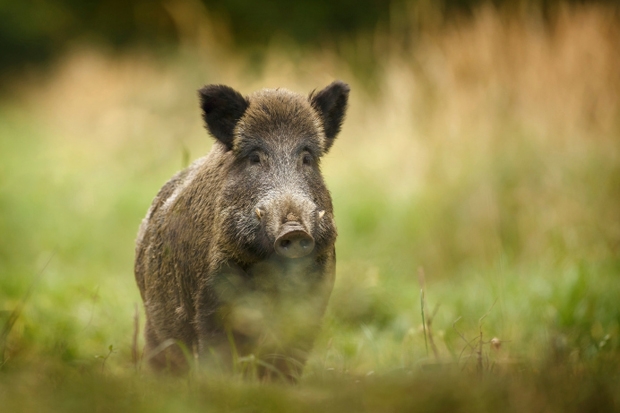It’s 15 years since I first wrote an article about the threat to the nation of the wild boar; but only now, following the death of a driver in a collision with one of these fearsome beasts on the M4 in Wiltshire, is anyone taking any notice (and not very much notice at that). The government is planning to introduce the same kind of road warning signs for wild boar as those that already exist for deer, horses, toads and ducks. ‘Road safety in the context of wild boars is an emerging issue that needs to be addressed,’ says roads minister John Hayes. ‘The addition of a warning sign for wild boar in areas with populations of the animals would be a sensible step to encourage people to slow down and watch out.’
It is certainly a good idea to watch out. Unlike toads or ducks, wild boar can weigh as much as the late Luciano Pavarotti: you really wouldn’t want to crash into one. But why is this only now described as an ‘emerging issue’? The journalist John Vidal drew our attention to it in the Guardian at the turn of the century. He warned that wild boar had started to recolonise southern England after being declared extinct in Britain more than 300 years earlier. The first sightings of boars in the wild had been made in the 1980s on Paul McCartney’s country estate in Sussex: they were assumed to have escaped from a zoo or from one of England’s handful of wild-boar farms. By 2000, said Vidal, it was estimated that there could already be as many as 500 of them roaming the woods of southern England. Now it is thought that that figure has risen to around 4,000. There were reported collisions with motorists 15 years ago, but only now is any effort being made to record the number of boar-related road accidents.
I admit that wild boars have a certain primeval beauty, but they are a menace. They trample crops, devastate gardens, destroy bluebell woods and eat practically anything, including lambs. They may even have cannibalistic tendencies: Princess Anne has just reported that a boar broke into her farm and killed a Gloucestershire Old Spot pig. Furthermore, wild boars spread swine fever and other diseases to the domestic pig population. They also mate with domestic sows, producing hybrid piglets. All this is very depressing for pig farmers.
They obviously should be wiped out as quickly as possible, but all attempts to reduce their numbers are being opposed by conservationists and animal-rights campaigners. Many of the former are rejoicing at the return to Britain of a ‘native’ species — its largest mammal, the king of the forest — after an absence of a few hundred years. Well, yes, it was ‘native’ once, but that was when England was covered with forest. It was the shrinking of the forest that led to its eventual extinction in the 17th century, and it’s certainly not native to an overpopulated country of farms and gardens criss-crossed by trunk roads and motorways.
One reason why wild boars multiply and prosper is that they have no natural predators any more, because the animals that used to kill them — the wolf and the lynx — have also become extinct. I expect that there are many people who would like to reintroduce these species too, but I doubt if that would go down very well in the Home Counties. In southern Europe they hunt wild boar with hounds, but of course that would be illegal here. So there seems to be nothing for it but to shoot them in as large numbers as possible. The Forestry Commission culls modest numbers of wild boar on its own land, but private landowners seem reluctant to risk the wrath of the animal-rights people by doing the same. It’s their patriotic duty to be brave and organise wild-boar shoots, whatever the opposition. After all, wild boars aren’t even classified as game, so they could go on shooting them all year round, even during the breeding season.






Comments